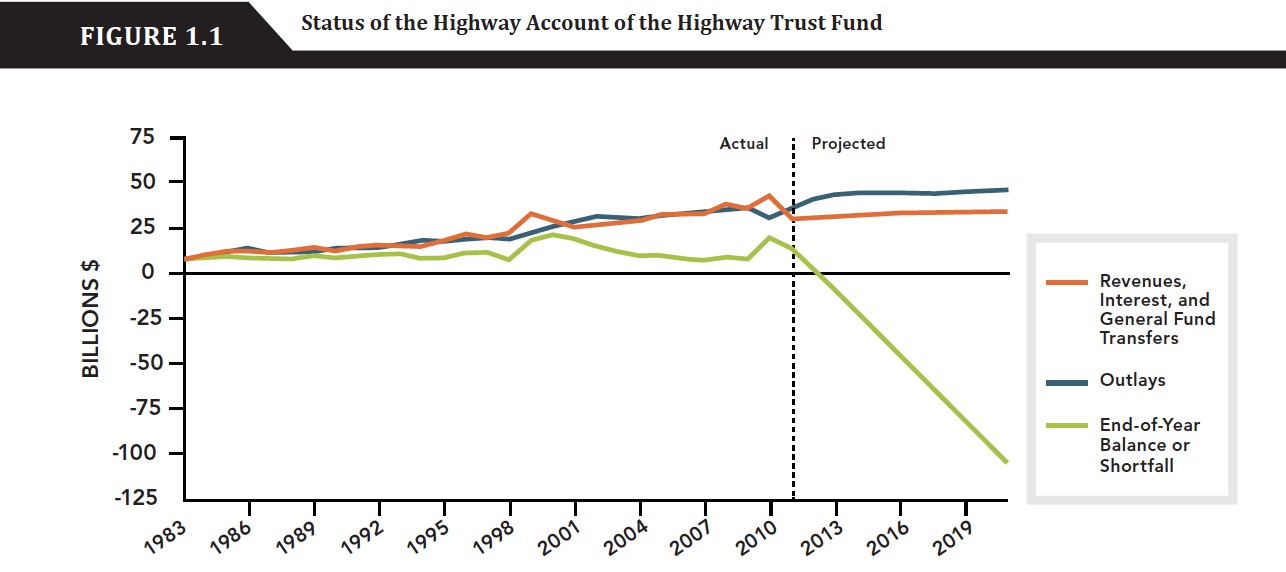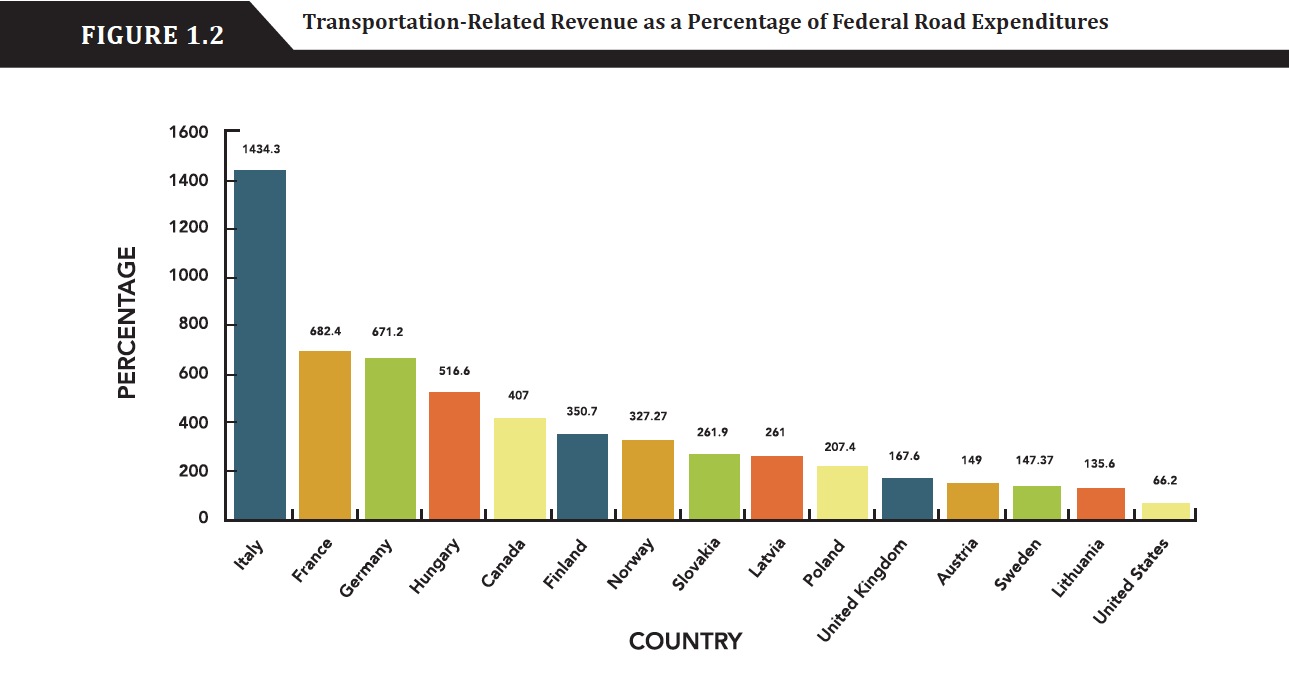THE LEADERSHIP INITIATIVE ON TRANSPORTATION SOLVENCY
Introduction
The Leadership Initiative for Transportation Solvency is dedicated to developing a nonpartisan solution to fund a better transportation system in the United States. Former U.S. Senator Bill Bradley, former Pennsylvania Governor and Secretary of Homeland Security Tom Ridge, and former U.S. Comptroller General and current President of the Comeback America Initiative David Walker led an intensive analysis to find politically realistic measures to fund and fix the transportation program.
In recent years, the U.S. surface transportation system added nearly $175 billion annually to the national deficit, including deferred maintenance. The United States is one of only a handful of countries in the world where revenues raised to support the federal transportation system do not cover costs. Revenues represent just 62 percent of federal surface transportation expenditures, while all other members of the Organization for Economic Cooperation and Development, the group of developed economies, more than cover 100 percent of their transportation expenditures through user taxes—and sometimes several times over. Also, the practice of deferred maintenance unnecessarily contributes to this burden by increasing the cost of system upkeep to as much as $800,000 per lane mile over the life of the road.
There are tangible economic benefits from the transportation system apparent in the ability of households and firms to access markets. But the benefits are waning. The rate of economic return from investment in highway infrastructure in the United States has been approaching the long-term interest rate (cost of capital) since the 1990s. Once the rate of economic return meets the long-term interest rate, it becomes equally beneficial to keep invested capital in the private sector,3 a clear signal that those investments could be without merit. At that point, the system no longer delivers the benefits necessary to justify public funds. While a 2011 national public opinion poll found that 79 percent of the public agrees that “in order for the United States to remain the world’s top economic superpower we need to modernize our transportation infrastructure and keep it up to date,” in the same poll 64 percent of the public felt that federal spending on transportation infrastructure is “inefficient and unwise.” Not only is there an enormous fiscal burden, but the system’s dependence on oil intensifies the problem. Oil represents 94 percent of transportation fuels and transportation is responsible for nearly 75 percent of U.S. oil consumption.
In 2010, our national bill for oil dependence came to $323 billion—2.2 percent of GDP. This includes the importation of foreign crude oil and petroleum byproducts, and the dollar amount equals 17 percent of all import costs. This dependence comes with a national security risk: some 4.75 million barrels per day (about 50 percent of total imports) were purchased from nine countries categorized by the State Department as unstable.
Oil dependence also hinders our ability to deal with climate challenges. Thirty-four percent of U.S. carbon emissions come from the transportation sector and 80 percent of the carbon is emitted exclusively by internal combustion engines. Research conducted by NASA’s Goddard Institute for Space Studies and other climate agencies finds that on-road transport has the greatest negative effect on climate—more than power generation or any other sector—especially in the short term.
While the country suffers the effects of an increasingly degraded and under performing transportation system, investment decisions on the nation’s transportation system have become increasingly unfocused, short-term, and highly politicized.10 In 1987, President Ronald Reagan vetoed a transportation funding bill because it contained 100 earmarks; in 2005, President George W. Bush signed a subsequent transportation funding bill containing 6,229 earmarks without objection. Since the completion of the Interstate Highway System more than twenty years ago, states and metropolitan areas have cobbled together their own project and investment plans for highway, transit, and rail, but this piecemeal approach prevents the smooth integration of local, state, and federal policies and hinders potential synergies across projects. This approach also compromises federal oversight and accountability, making it difficult to measure performance and set appropriate authorization levels for the future.
These shortfalls in our federal transportation program do not justify abandoning federal transportation assistance—quite the opposite, actually. A nation’s transportation system is a major actor in its economy, deserving investment and requiring federal funding and oversight. Changes to the system will help ensure future economic growth, recognize demographic and geographic shifts in both population and preferences, advance environmental and energy security, and embrace and support innovation. All of these items are necessary to maintain global competitiveness and guarantee future prosperity. For example, higher levels of federal transportation investment are merited in urban areas where more than two-thirds of the country’s population now lives and there are economic, environmental, and social benefits that can be gained. Instead of simply building capacity—as the current transportation program tacitly promotes— incremental investments in a mature U.S. transportation system should be applied sensitively and the prioritization of project investments can be evaluated through economic analysis.
Realizing the many benefits from a functional transportation system requires a national vision and greater accountability by using performance metrics derived from strategic goals. But without new revenue to meet transportation infrastructure needs, the benefits of any restructuring will remain largely unrealized. Systematic pricing is required for the transportation system to serve the public interest in a responsive, trustworthy, and cost-effective manner. Twenty-first century transportation policy necessarily draws a close relationship between program design and its funding mechanism.
Pricing transportation and better optimizing transportation investments will also bring tangible security and prosperity gains. Benefits accrue to individuals and society as a whole. These benefits include reductions in fuel consumption and pollution, public health improvements including better respiratory health and greater levels of physical activity, more efficient movement of goods, services, and passengers, and economic benefits through clusters of firms with convenient and affordable transportation and communications networks.
Strategies for pricing transportation abound. Options include pricing the carbon content of fuels, low-mileage vehicles, inefficient travel behavior, and emissions in the development of refined petroleum products.
For the nation’s economic, energy, and environmental security, we, three leaders representing the U.S. political spectrum, recommend that a solvent transportation program be ensured through the stable pricing of oil and petroleum products as the best immediate strategy. This strategy reflects the current transportation system and its dependence on oil by capturing and distributing the external, social, and hidden costs generated by the production, refining, distribution, and consumption of such fuels.
Specifically, our proposal assesses a 5 percent ad valorem tax on oil upstream (at production or importation) as the world oil price rises, and tax on gasoline/diesel downstream (retail sales) as the world oil price declines. This will dampen oil demand on the way up (to avoid a price spike) and slow price crashes on the way down (to encourage price stabilization and recover reductions in ad valorem tax revenues due to lower oil prices). If prices get too high or too low despite these efforts, the ad valorem tax can be recalibrated, as necessary, to stabilize transportation fuel costs while also funding a transportation program designed to advance federal goals. Benefits of this strategy include distributing revenue responsibilities along the oil value chain from production to consumption; buffering the impact of external events and oil supplies over which the United States has no control; and stabilizing fuel prices for both producers and consumers for long-term market equilibrium.
It is time for a significant recalibration of America’s federal transportation program. Poorly designed and obsolete programs must be eliminated. At the same time, America needs more targeted investment in projects that grow the economy and serve the key national objectives of security and prosperity. System costs—direct and hidden—must be incorporated into the pricing system to again fund transportation on a pay-as-you-go basis. Further delay in implementing these reforms only accelerates deterioration in the system while causing transportation’s contribution to the national debt to snowball. Kicking the can of revenue and program reform down the road does not help us live within our means—it simply transfers these burgeoning costs to future generations of Americans. This is both short-sighted and unfair. We can delay no longer: the time to act is now.
Download the full version (PDF): Road to Recovery: Transforming America’s Transportation
About The Leadership Initiative on Transportation Solvency
carnegieendowment.org/publications/special/misc/transportation/
“The Carnegie Endowment for International Peace has created a leadership initiative to develop a non-partisan solution funding a better transportation system in the United States. Former U.S. Senator Bill Bradley, former Pennsylvania Governor and Secretary for Homeland Security Tom Ridge, and former U.S. Comptroller General and now founder and CEO of the Comeback America Initiative David Walker led the initiative and recently released their landmark report, The Road to Recovery: Transforming America’s Transportation, detailing their recommendations for reforming and funding the Federal Transportation Program “
Tags: Carnegie Endowment for International Peace, Rockefeller Foundation








 RSS Feed
RSS Feed